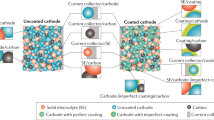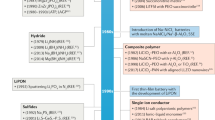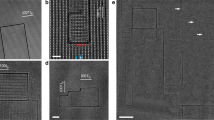Abstract
Models of the electrical double layer (EDL) at electrode/liquid-electrolyte interfaces no longer hold for all-solid-state electrochemistry. Here we show a more general model for the EDL at a solid-state electrochemical interface based on the Poisson–Fermi–Dirac equation. By combining this model with density functional theory predictions, the interconnected electronic and ionic degrees of freedom in all-solid-state batteries, including the electronic band bending and defect concentration variation in the space-charge layer, are captured self-consistently. Along with a general mathematical solution, the EDL structure is presented in various materials that are thermodynamically stable in contact with a lithium metal anode: the solid electrolyte Li7La3Zr2O12 (LLZO) and the solid interlayer materials LiF, Li2O and Li2CO3. The model further allows design of the optimum interlayer thicknesses to minimize the electrostatic barrier for lithium ion transport at relevant solid-state battery interfaces.
This is a preview of subscription content, access via your institution
Access options
Access Nature and 54 other Nature Portfolio journals
Get Nature+, our best-value online-access subscription
$29.99 / 30 days
cancel any time
Subscribe to this journal
Receive 12 digital issues and online access to articles
$99.00 per year
only $8.25 per issue
Buy this article
- Purchase on Springer Link
- Instant access to full article PDF
Prices may be subject to local taxes which are calculated during checkout





Similar content being viewed by others
Data availability
The first-principles computational results on charged point defects and band alignments that were used to find the input parameters for this model are available in the NOMAD repository71 at https://doi.org/10.17172/NOMAD/2021.02.12-1.
Code availability
The python script PFD_solution.py constructs the analytic approximations ϕ1 and ϕ2. It may be used to reproduce the results in Tables 1 and 2, or to extend the method to another material. PFD_solution.py is available at72 https://github.com/mwswift/PFD_solution and https://doi.org/10.5281/zenodo.4538867. The Mathematica notebooks used to find the numerical solutions and generate the space-charge layer profiles and potential profiles are also available in this repository, as well as in the Wolfram cloud at https://www.wolframcloud.com/obj/swift/Published/PFD_Interlayers.nb and https://www.wolframcloud.com/obj/swift/Published/PFD_LLZO.nb.
References
Janek, J. & Zeier, W. G. A solid future for battery development. Nat. Energy 1, 16141 (2016).
Manthiram, A., Yu, X. & Wang, S. Lithium battery chemistries enabled by solid-state electrolytes. Nat. Rev. Mater. 2, 16103 (2017).
Randau, S. et al. Benchmarking the performance of all-solid-state lithium batteries. Nat. Energy 5, 259–270 (2020).
Bard, A. & Faulkner, L. Electrochemical Methods: Fundamentals and Applications 2nd edn (Wiley, 2000).
Helmholtz, H. Ueber einige gesetze der vertheilung elektrischer ströme in körperlichen leitern mit anwendung auf die thierisch-elektrischen versuche. Ann. Phys. 165, 211–233 (1853).
Stern, O. Zur theorie der elektrolytischen doppelschicht. Z. Elektrochem. Angew. Physik. Chem. 30, 508–516 (1924).
Schmickler, W. Interfacial Electrochemistry (Oxford Univ. Press, 1996).
Nakamura, M., Sato, N., Hoshi, N. & Sakata, O. Outer Helmholtz plane of the electrical double layer formed at the solid electrode–liquid interface. ChemPhysChem 12, 1430–1434 (2011).
Otani, M. & Sugino, O. First-principles calculations of charged surfaces and interfaces: a plane-wave nonrepeated slab approach. Phys. Rev. B 73, 115407 (2006).
Jinnouchi, R. & Anderson, A. B. Electronic structure calculations of liquid-solid interfaces: combination of density functional theory and modified Poisson–Boltzmann theory. Phys. Rev. B 77, 245417 (2008).
Nattino, F., Truscott, M., Marzari, N. & Andreussi, O. Continuum models of the electrochemical diffuse layer in electronic-structure calculations. J. Chem. Phys. 150, 041722 (2019).
Swift, M. W. & Qi, Y. First-principles prediction of potentials and space-charge layers in all-solid-state batteries. Phys. Rev. Lett. 122, 167701 (2019).
Tateyama, Y., Gao, B., Jalem, R. & Haruyama, J. Theoretical picture of positive electrode–solid electrolyte interface in all-solid-state battery from electrochemistry and semiconductor physics viewpoints. Curr. Opin. Electrochem. 17, 149–157 (2019).
de Klerk, N. J. J. & Wagemaker, M. Space-charge layers in all-solid-state batteries; important or negligible? ACS Appl. Energy Mater. 1, 5609–5618 (2018).
Fingerle, M., Buchheit, R., Sicolo, S., Albe, K. & Hausbrand, R. Reaction and space charge layer formation at the LiCoO2–LiPON interface: insights on defect formation and ion energy level alignment by a combined surface science-simulation approach. Chem. Mater 29, 7675–7685 (2017).
Braun, S., Yada, C. & Latz, A. Thermodynamically consistent model for space-charge-layer formation in a solid electrolyte. J. Phys. Chem. C 119, 22281–22288 (2015).
Haruyama, J., Sodeyama, K., Han, L., Takada, K. & Tateyama, Y. Space-charge layer effect at interface between oxide cathode and sulfide electrolyte in all-solid-state lithium-ion battery. Chem. Mater 26, 4248–4255 (2014).
Marcicki, J., Conlisk, A. & Rizzoni, G. A lithium-ion battery model including electrical double layer effects. J. Power Sources 251, 157–169 (2014).
Kasamatsu, S., Tada, T. & Watanabe, S. Parallel-sheets model analysis of space charge layer formation at metal/ionic conductor interfaces. Solid State Ion. 226, 62–70 (2012).
Morgan, B. J. & Madden, P. A. Effects of lattice polarity on interfacial space charges and defect disorder in ionically conducting AgI heterostructures. Phys. Rev. Lett. 107, 206102 (2011).
Maier, J. Ionic conduction in space charge regions. Prog. Solid State Chem. 23, 171–263 (1995).
Aizawa, Y. et al. In situ electron holography of electric potentials inside a solid-state electrolyte: effect of electric-field leakage. Ultramicroscopy 178, 20–26 (2017).
Gittleson, F. S. & El Gabaly, F. Non-Faradaic Li+ migration and chemical coordination across solid-state battery interfaces. Nano Lett. 17, 6974–6982 (2017).
Masuda, H., Ishida, N., Ogata, Y., Ito, D. & Fujita, D. Internal potential mapping of charged solid-state-lithium ion batteries using in situ kelvin probe force microscopy. Nanoscale 9, 893–898 (2017).
Luntz, A. C., Voss, J. & Reuter, K. Interfacial challenges in solid-state Li ion batteries. J. Phys. Chem. Lett. 6, 4599–4604 (2015).
Haruta, M. et al. Negligible ‘negative space-charge layer effects’ at oxide-electrolyte/electrode interfaces of thin-film batteries. Nano Lett. 15, 1498–1502 (2015).
Xiao, Y. et al. Understanding interface stability in solid-state batteries. Nat. Rev. Mater 5, 105–126 (2020).
Zhao, Q., Stalin, S., Zhao, C.-Z. & Archer, L. A. Designing solid-state electrolytes for safe, energy-dense batteries. Nat. Rev. Mater 5, 229–252 (2020).
Tan, D. H. S., Banerjee, A., Chen, Z. & Meng, Y. S. From nanoscale interface characterization to sustainable energy storage using all-solid-state batteries. Nat. Nanotechnol. 15, 170–180 (2020).
Early, J. M. Effects of space-charge layer widening in junction transistors. Proc. IRE 40, 1401–1406 (1952).
van Heek, H. Hall mobility of electrons in the space-charge layer of thin film CdSe transistors. Solid State Electron. 11, 459–462 (1968).
Belisle, R. A. et al. Interpretation of inverted photocurrent transients in organic lead halide perovskite solar cells: proof of the field screening by mobile ions and determination of the space charge layer widths. Energy Environ. Sci. 10, 192–204 (2017).
Vollman, M. & Waser, R. Grain boundary defect chemistry of acceptor-doped titanates: space charge layer width. J. Am. Ceram. Soc. 77, 235–243 (1994).
De Souza, R. A. The formation of equilibrium space-charge zones at grain boundaries in the perovskite oxide SrTiO3. Phys. Chem. Chem. Phys. 11, 9939–9969 (2009).
Lupetin, P., Gregori, G. & Maier, J. Mesoscopic charge carriers chemistry in nanocrystalline SrTiO3. Angew. Chem. Int. Ed. 49, 10123–10126 (2010).
Freysoldt, C. et al. First-principles calculations for point defects in solids. Rev. Mod. Phys. 86, 253–305 (2014).
Yang, J., Youssef, M. & Yildiz, B. Predicting point defect equilibria across oxide hetero-interfaces: model system of ZrO2/Cr2O3. Phys. Chem. Chem. Phys. 19, 3869–3883 (2017).
Bowes, P. C., Wu, Y., Baker, J. N., Harris, J. S. & Irving, D. L. Space charge control of point defect spin states in AlN. Appl. Phys. Lett 115, 052101 (2019).
Pan, J., Zhang, Q., Xiao, X., Cheng, Y.-T. & Qi, Y. Design of nanostructured heterogeneous solid ionic coatings through a multiscale defect model. ACS Appl. Mater. Interfaces 8, 5687–5693 (2016).
Grundmann, M. in The Physics of Semiconductors: An Introduction Including Nanophysics and Applications 525–527 (Springer, 2010).
Johnson, R. A. Use of Fermi–Dirac statistics for defects in solids. Phys. Rev. B 24, 7383–7384 (1981).
Das, T., Nicholas, J. D. & Qi, Y. Long-range charge transfer and oxygen vacancy interactions in strontium ferrite. J. Mater. Chem. A 5, 4493–4506 (2017).
Sallaz, V., Oukassi, S., Voiron, F., Salot, R. & Berardan, D. Assessing the potential of LiPON-based electrical double layer microsupercapacitors for on-chip power storage. J. Power Sources 451, 227786 (2020).
Zhu, Y., He, X. & Mo, Y. Origin of outstanding stability in the lithium solid electrolyte materials: insights from thermodynamic analyses based on first-principles calculations. ACS Appl. Mater. Interfaces 7, 23685–23693 (2015).
Luo, J. Let thermodynamics do the interfacial engineering of batteries and solid electrolytes. Energy Storage Mater. 21, 50–60 (2019).
Zhang, L., Zhang, K., Shi, Z. & Zhang, S. LiF as an artificial SEI layer to enhance the high-temperature cycle performance of Li4Ti5O12. Langmuir 33, 11164–11169 (2017).
Wang, A., Kadam, S., Li, H., Shi, S. & Qi, Y. Review on modeling of the anode solid electrolyte interphase (SEI) for lithium-ion batteries. npj Comput. Mater. 4, 15 (2018).
Jurng, S., Brown, Z. L., Kim, J. & Lucht, B. L. Effect of electrolyte on the nanostructure of the solid electrolyte interphase (SEI) and performance of lithium metal anodes. Energy Environ. Sci. 11, 2600–2608 (2018).
Bhattacharya, S., Riahi, A. R. & Alpas, A. T. Electrochemical cycling behaviour of lithium carbonate (Li2CO3) pre-treated graphite anodes—SEI formation and graphite damage mechanisms. Carbon 77, 99–112 (2014).
Eijima, S. et al. Solid electrolyte interphase film on lithium metal anode in mixed-salt system. J. Electrochem. Soc 166, A5421–A5429 (2019).
Wang, M. et al. Tailoring lithium deposition via an SEI-functionalized membrane derived from LiF decorated layered carbon structure. Adv. Energy Mater. 9, 1802912 (2019).
Murugan, R., Thangadurai, V. & Weppner, W. Fast lithium ion conduction in garnet-type Li7La3Zr2O12. Angew. Chem. Int. Ed. 46, 7778–7781 (2007).
Wang, Y. et al. Design principles for solid-state lithium superionic conductors. Nat. Mater. 14, 1026–1031 (2015).
Xie, H., Alonso, J. A., Li, Y., Fernández-Díaz, M. T. & Goodenough, J. B. Lithium distribution in aluminum-free cubic Li7La3Zr2O12. Chem. Mater. 23, 3587–3589 (2011).
Cussen, E. J. The structure of lithium garnets: cation disorder and clustering in a new family of fast Li+ conductors. Chem. Commun. 4, 412–413 (2006).
O’Callaghan, M. P. & Cussen, E. J. Lithium dimer formation in the Li-conducting garnets Li5+xBaxLa3xTa2O12(0 < x ≤ 1.6). Chem. Commun. 20, 2048–2050 (2007).
Tian, H.-K., Xu, B. & Qi, Y. Computational study of lithium nucleation tendency in Li7La3Zr2O12 (LLZO) and rational design of interlayer materials to prevent lithium dendrites. J. Power Sources 392, 79–86 (2018).
Pinson, M. B. & Bazant, M. Z. Theory of SEI formation in rechargeable batteries: capacity fade, accelerated aging and lifetime prediction. J. Electrochem. Soc. 160, A243 (2013).
Huggins, R. Advanced Batteries: Materials Science Aspects (Springer, 2008).
Pan, J., Cheng, Y.-T. & Qi, Y. General method to predict voltage-dependent ionic conduction in a solid electrolyte coating on electrodes. Phys. Rev. B 91, 134116 (2015).
Ong, S. P. et al. Python materials genomics (pymatgen): a robust, open-source python library for materials analysis. Comput. Mater. Sci. 68, 314–319 (2013).
Broberg, D. et al. Pycdt: a python toolkit for modeling point defects in semiconductors and insulators. Comput. Phys. Commun. 226, 165–179 (2018).
Kresse, G. & Furthmüller, J. Efficient iterative schemes for ab initio total-energy calculations using a plane-wave basis set. Phys. Rev. B 54, 11169–11186 (1996).
Perdew, J. P., Burke, K. & Ernzerhof, M. Generalized gradient approximation made simple. Phys. Rev. Lett. 77, 3865–3868 (1996).
Blöchl, P. E. Projector augmented-wave method. Phys. Rev. B 50, 17953–17979 (1994).
Jain, A. et al. A high-throughput infrastructure for density functional theory calculations. Comput. Mater. Sci. 50, 2295 – 2310 (2011).
Jain, A. et al. Commentary: the materials project: a materials genome approach to accelerating materials innovation. APL Mater. 1, 011002 (2013).
Ong, S. P. et al. The materials application programming interface (API): a simple, flexible and efficient API for materials data based on representational state transfer (rest) principles. Comput. Mater. Sci. 97, 209–215 (2015).
Freysoldt, C., Neugebauer, J. & Van de Walle, C. G. Fully ab initio finite-size corrections for charged-defect supercell calculations. Phys. Rev. Lett. 102, 016402 (2009).
Freysoldt, C., Neugebauer, J. & Van de Walle, C. G. Electrostatic interactions between charged defects in supercells. Phys. Status Solidi B 248, 1067–1076 (2011).
Swift, M. W., Swift, J. W. & Qi, Y. Modeling the electrical double layer at solid-state electrochemical interfaces. NOMAD https://doi.org/10.17172/NOMAD/2021.02.12-1 (2021).
Swift, M. W., Swift, J. W. & Qi, Y. Poisson–Fermi–Dirac solution v1.0. Zenodo https://doi.org/10.5281/zenodo.4538867 (2021).
Acknowledgements
This work was mainly supported by the Nanostructures for Electrical Energy Storage (NEES) centre, an Energy Frontier Research Center funded by the US Department of Energy, Office of Science, Basic Energy Sciences under award number DESC0001160. Y.Q. also acknowledge the support from the Assistant Secretary for Energy Efficiency and Renewable Energy, Vehicle Technologies Office of the US Department of Energy under contract no. award number DE-EE0008863 under the Battery Material Research (BMR) Program.
Author information
Authors and Affiliations
Contributions
Conceptualization, M.W.S. and Y.Q.; methodology, M.W.S., J.W.S. and Y.Q.; software, M.W.S. and J.W.S.; investigation, M.W.S., J.W.S. and Y.Q.; writing—original draft, M.W.S. and Y.Q.; writing—review and editing, M.W.S., J.W.S. and Y.Q.; supervision, Y.Q.; funding acquisition, Y.Q.
Corresponding authors
Ethics declarations
Competing interests
The authors declare no competing interests.
Additional information
Peer review information Nature Computational Science thanks the anonymous reviewers for their contribution to the peer review of this work. Fernando Chirigati was the primary editor on this article and managed its editorial process and peer review in collaboration with the rest of the editorial team.
Publisher’s note Springer Nature remains neutral with regard to jurisdictional claims in published maps and institutional affiliations.
Supplementary information
Supplementary Information
Supplementary Figs. 1–3 and Table 1.
Source data
Source Data Fig. 2
Numerical solution data.
Source Data Fig. 3
Density functional theory calculated data.
Source Data Fig. 4
Numerical solution data.
Source Data Fig. 5
Numerical solution data.
Rights and permissions
About this article
Cite this article
Swift, M.W., Swift, J.W. & Qi, Y. Modeling the electrical double layer at solid-state electrochemical interfaces. Nat Comput Sci 1, 212–220 (2021). https://doi.org/10.1038/s43588-021-00041-y
Received:
Accepted:
Published:
Issue Date:
DOI: https://doi.org/10.1038/s43588-021-00041-y
This article is cited by
-
Capacitive tendency concept alongside supervised machine-learning toward classifying electrochemical behavior of battery and pseudocapacitor materials
Nature Communications (2024)
-
Atomic-level polarization in electric fields of defects for electrocatalysis
Nature Communications (2023)
-
Electrochemo-poromechanics of Ionic Polymer Metal Composites: Towards the Accurate Finite Element Modelling of Actuation and Sensing
Journal of Elasticity (2023)
-
Dynamical phase-field model of coupled electronic and structural processes
npj Computational Materials (2022)
-
Interpretable learning of voltage for electrode design of multivalent metal-ion batteries
npj Computational Materials (2022)



